Sending Engage Connection Invites to HCPs
- iPad
- iPhone
Users can send Engage connection invites to HCPs directly from Veeva CRM. Connecting with HCPs allows users to chat with them in Engage.
Users must have an active internet connection to send connection invites.
Users can send Engage connection invites to HCPs from the following entry points:
- Engage Tab – invites are not linked to accounts
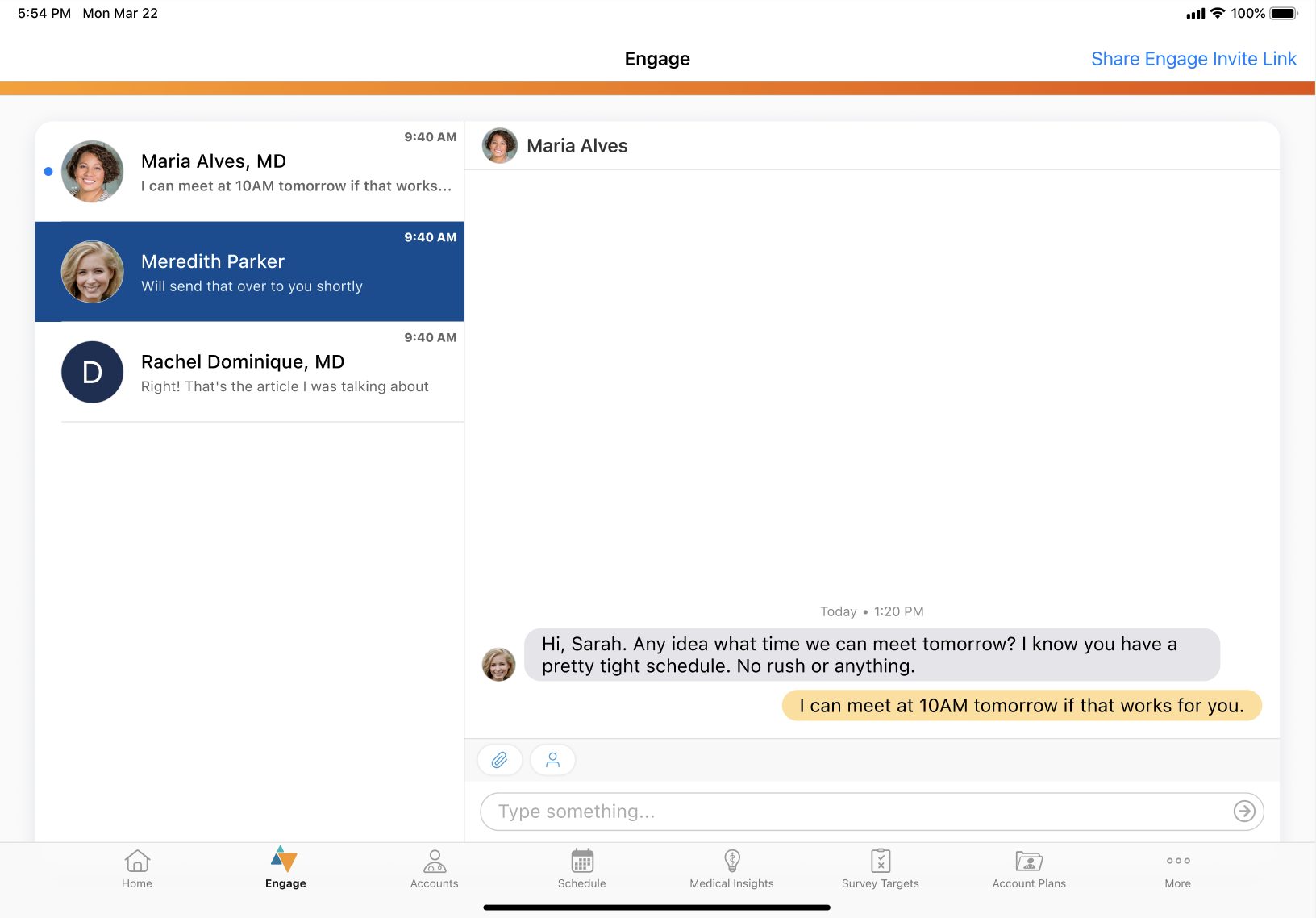
- Engage profile indicator on the HCP’s account – invites are linked to specific accounts
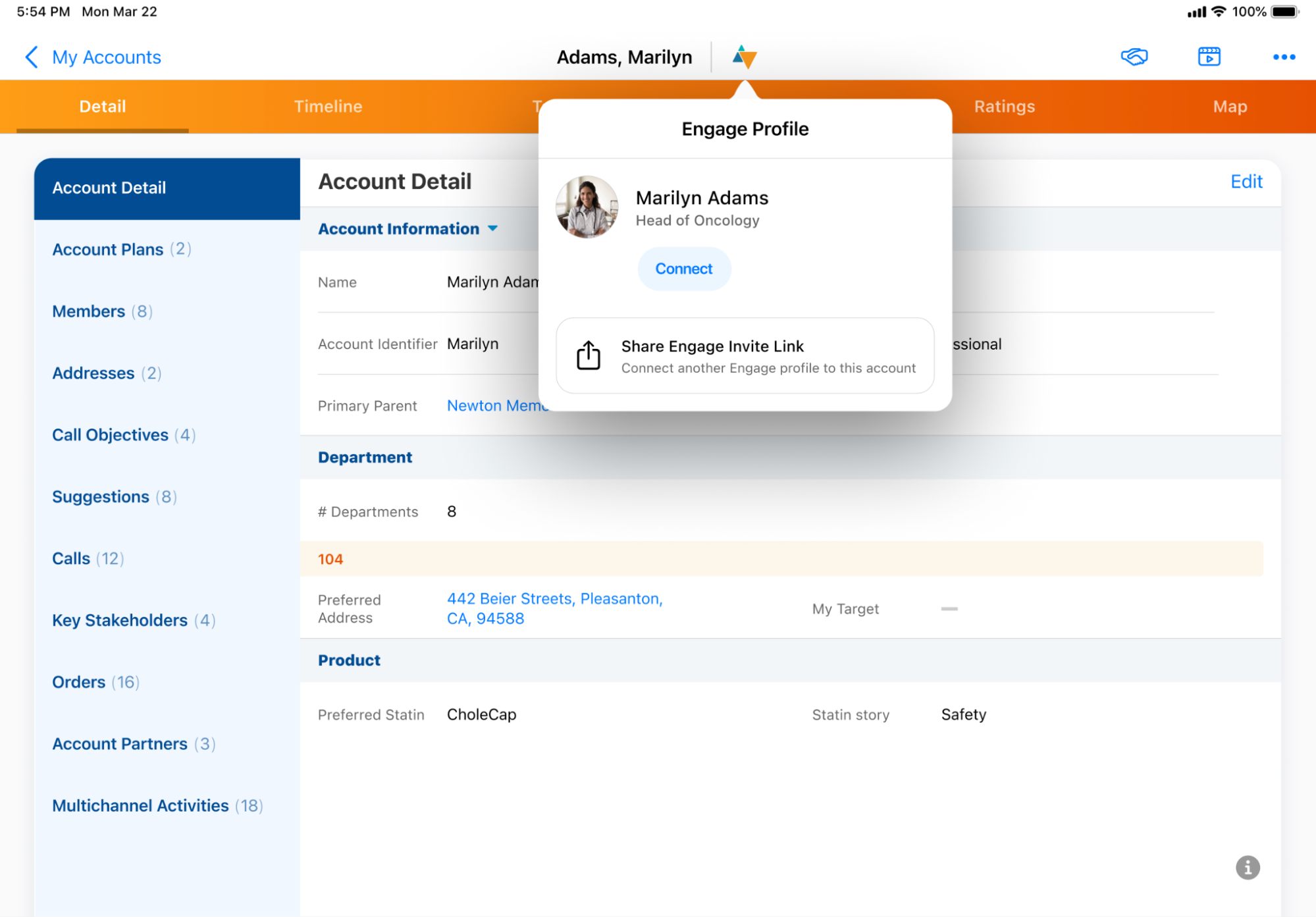
- The More Actions menu in the My Accounts list and the Account Details screen for HCP accounts – invites are linked to specific accounts
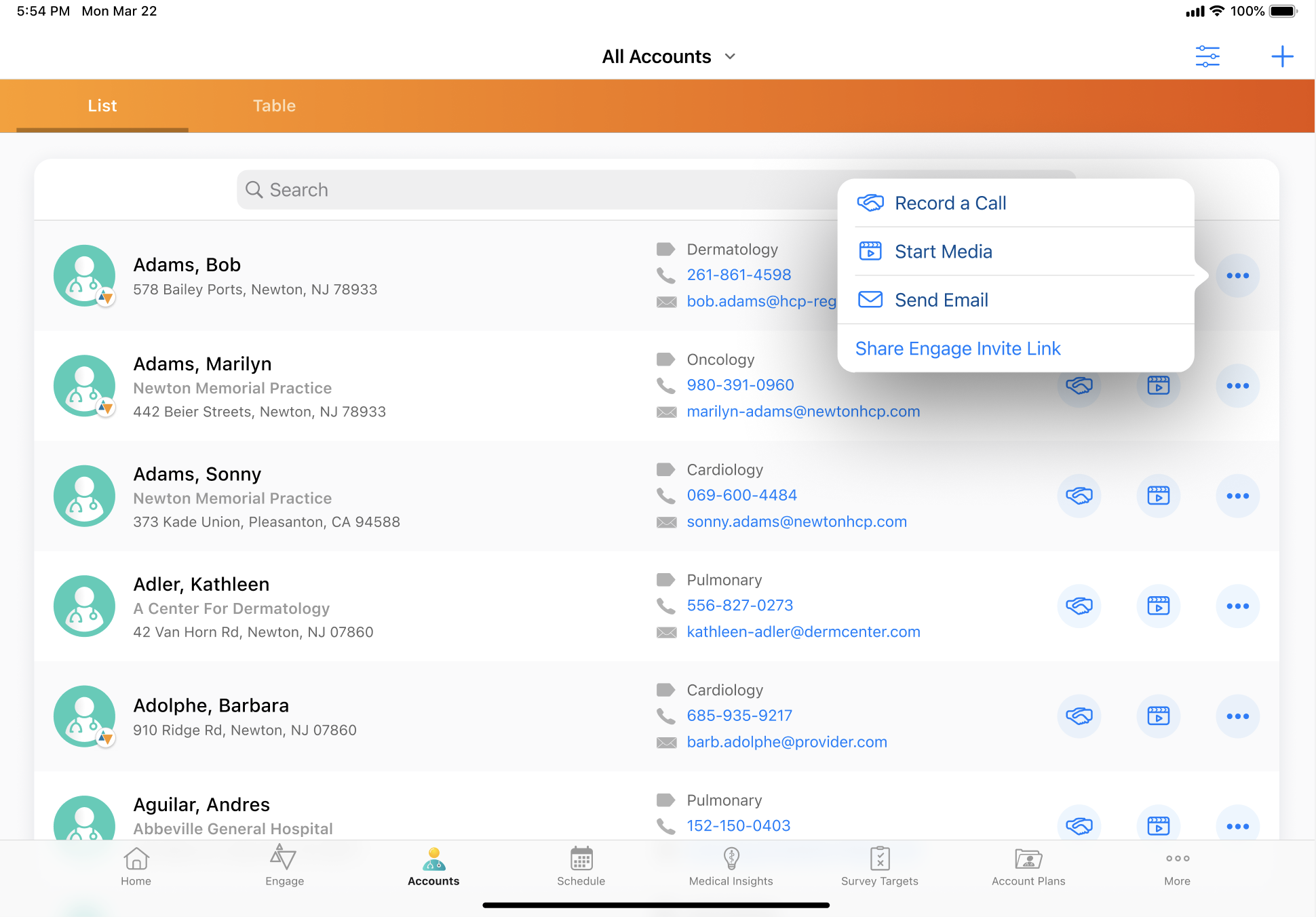
- The Share Digital Business Card homepage component
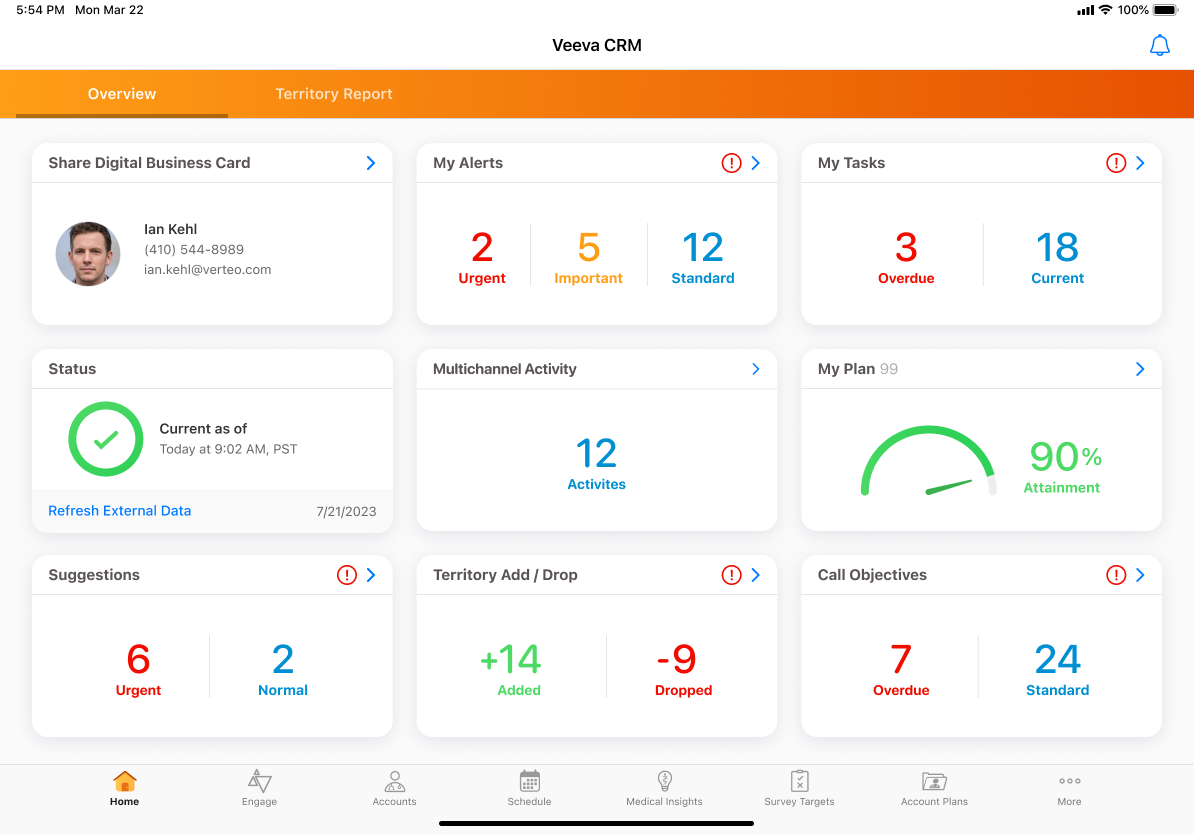
If an HCP connects with a user via a connection invite linked to their account, the HCP's Engage profile is automatically linked to the account and displays in the profile indicator after the user syncs.
Configuring Engage Connection Invites in CRM
-
Ensure either Digital Business Cards or the Engage Tab is configured for users who can send Engage connection invites. Configuring the Engage Tab automatically allows users to send invites from the tab.
- Ensure the Engage Profile Data Integration and the Engage Profile Indicator are configured to allow users to send Engage connection invites from Engage profile indicators on accounts.
- Ensure Sharing Digital Business Cards from the Home Page is configured to allow users to send Engage connection invites from the home page.
- Grant the integration user the following permissions:
Object
OLS
Record Types
Fields
FLS
Message_Activity_vod
CRU
Message_Activity_vod
- Activity_Datetime_vod
- Client_Device_vod
- Client_Name_vod
- Client_OS_vod
- IP_Address_vod
- Sent_Message_vod
- User_Agent_vod
Edit
Sent_Message_vod
CRU
Engage_Connection_Invite_vod
- Account_vod
- Call_vod
- Capture_Datetime_vod
- Clm_Presentation_vod
- Detail_Group_vod
- Details_vod
- Engage_Link_vod
- Engage_Profile_External_Id_vod
- Key_Message_vod
- Message_Config_Values_vod
- Mobile_ID_vod
- Opened_vod
- Product_vod
- Sent_Datetime_vod
- Sent_From_Platform_vod
- Sent_Phrase_vod
- Sent_Via_vod
- Shortened_Engage_Link_vod
- Transaction_Type_vod
- User_vod
- VExternal_Id_Vod
Edit
- Clicked_vod
- Click_Count_vod
- Downloaded_vod
- Download_Count_vod
- Viewed_vod
- View_Count_vod
Read
- Grant end users the following permissions:
Object
OLS
Record Types
Fields
FLS
Account_Overview_Layout_vod
n/a
n/a
zvod_Timeline_Message_vod
Read
Message_Activity_vod
R
n/a
- Activity_Datetime_vod
- Client_Device_vod
- Client_Name_vod
- Client_OS_vod
- IP_Address_vod
- Sent_Message_vod
- User_Agent_vod
Read
Sent_Message_vod
CRU
Engage_Connection_Invite_vod
- Account_vod
- Call_vod
- Capture_Datetime_vod
- Clm_Presentation_vod
- Detail_Group_vod
- Details_vod
- Engage_Link_vod
- Engage_Profile_External_Id_vod
- Key_Message_vod
- Message_Config_Values_vod
- Mobile_ID_vod
- Opened_vod
- Product_vod
- Sent_Datetime_vod
- Sent_From_Platform_vod
- Sent_Phrase_vod
- Sent_Via_vod
- Shortened_Engage_Link_vod
- Transaction_Type_vod
- User_vod
- VExternal_Id_Vod
Edit
- Clicked_vod
- Click_Count_vod
- Downloaded_vod
- Download_Count_vod
- Viewed_vod
- View_Count_vod
Read
- Ensure all picklist values are active for the following Sent_Message_vod fields:
- Sent_Via_vod
- Transaction_Type_vod
- Add the zvod_Timeline_Message_vod field to the appropriate Account_Overview_Layout_vod object page layout.
- Ensure VMOCs are active for the following objects for the appropriate platforms:
- Sent_Message_vod, with the following where clause:
- WHERE (Account_vod__r.Name != NULL AND CreatedDate = LAST_N_DAYS:90)
- Message_Activity_vod
- Engage_Link_Settings_vod
- Populate the ENGAGE_LINK_APPS_vod Engage Setting appropriately. The setting references the ENGAGE_LINK_APPS;;EngageLink Veeva Message. Edit the list in the Veeva Message to control the number and order of sharing options available for users to send links with accounts. Available values are:
- Messages
- LINE
- LINEWORKS
- EngageConnect
- CopyURL (includes QR Code®)
Copy URL and QR Code® always display as sharing options, even if they are not configured. Engage Connect is ignored if configured.
Use the format App1;;App2.
Sending an Engage Connection Invite to an HCP
To send a connection invite after navigating to one of the entry points:
- Select Share Engage Invite Link.
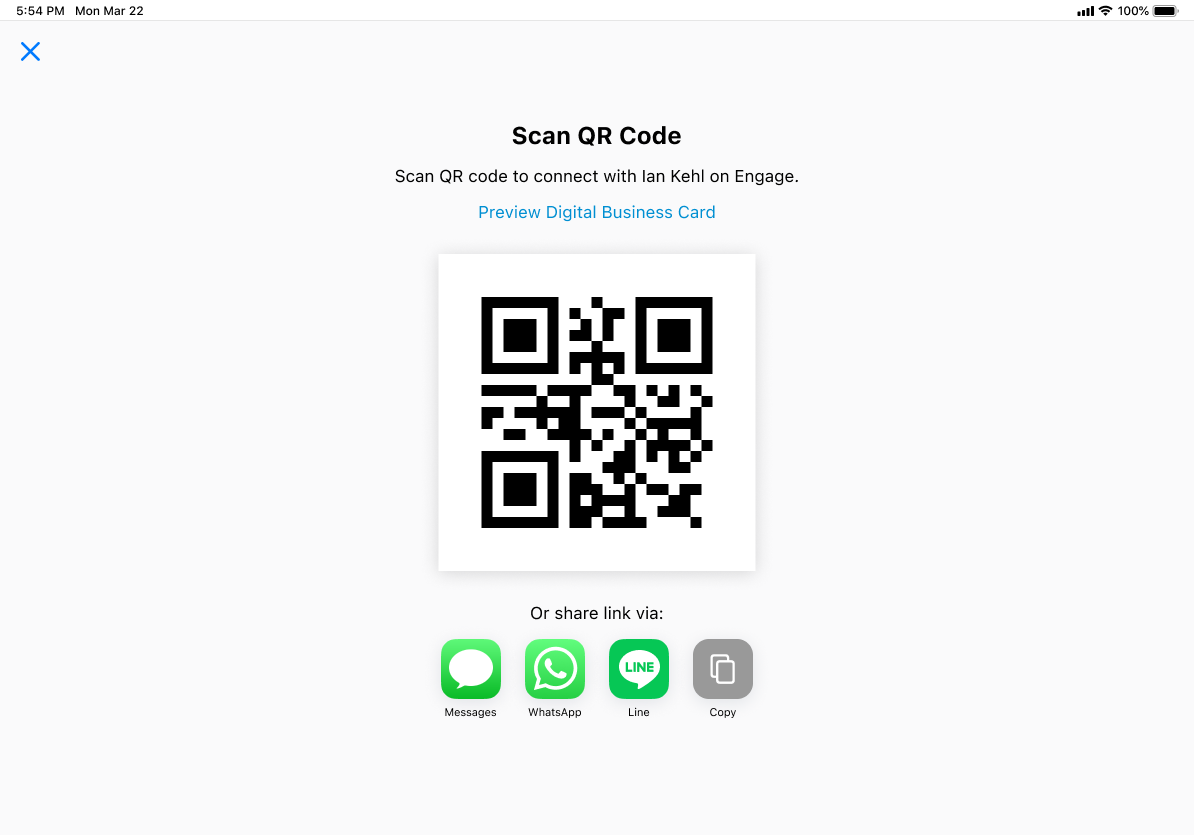
When the QR Code® is generated, a Sent_Message_vod record is immediately created.
- Select the appropriate sharing option. You can send the invite link to the HCP via QR Code® or a supported messaging app, or by copying the invite link and sending it via another messaging app.
When the HCP accepts the invite, a chat thread with the HCP is automatically created in the Engage tab for the user. If push notifications are enabled, you also receive a push notification.
If an account has a linked Engage profile but you are not connected and you have not previously sent a connection invite in Engage Connect, the Connect button displays in the Engage profile indicator. Select Connect to send the invite. The HCP receives an in-app notification and an email notification informing them of the connection invite.

You can send connection invites to HCP who do not have linked Engage profiles. For accounts that do not have linked Engage profiles, the Engage profile indicator displays as grayed out on the Account Details screen. You can still select the indicator and select Share Engage Invite Link.
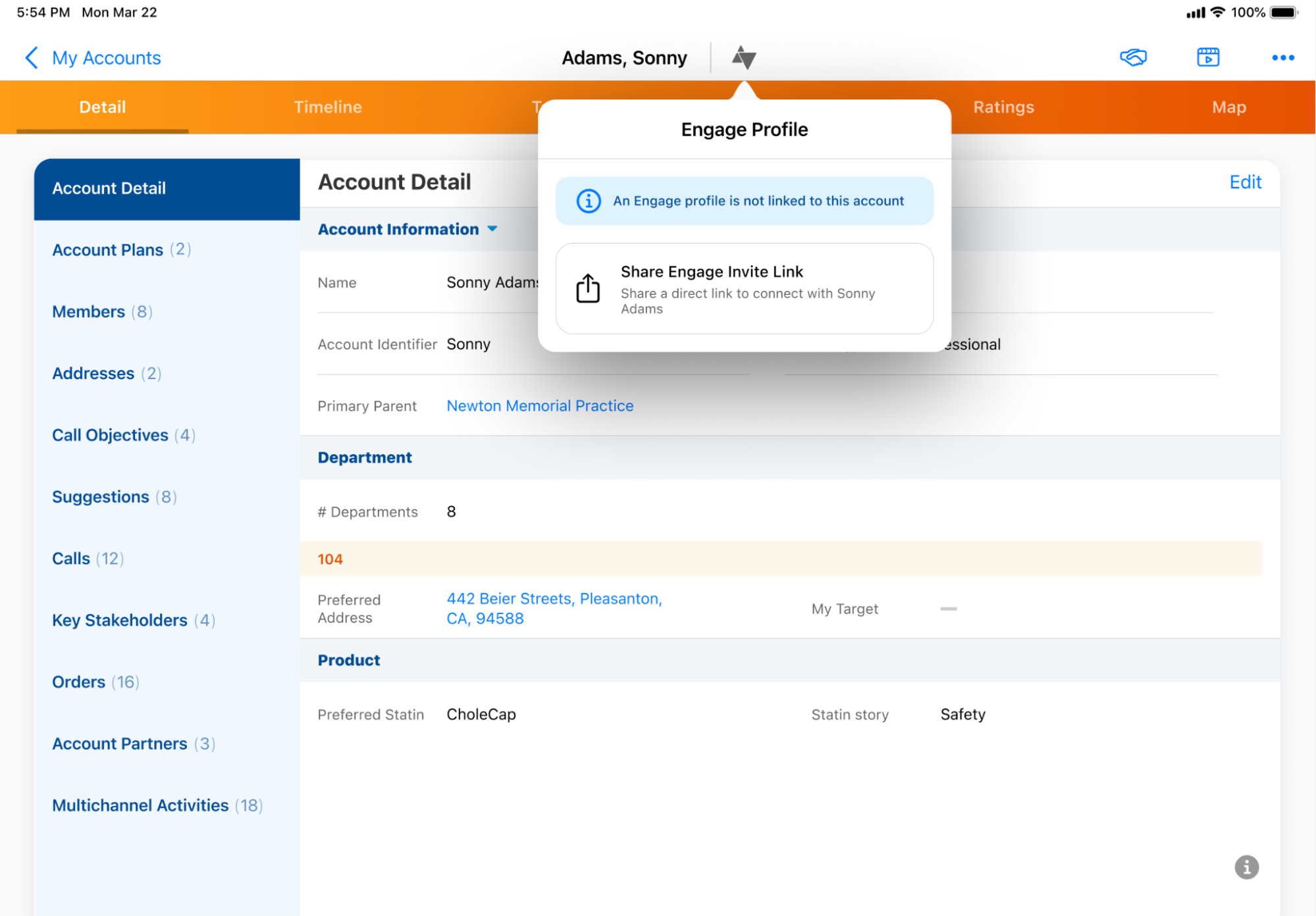
Adding Digital Business Cards to Apple Wallet on iPhone
Users can add the QR Code®s for their digital business cards to the Apple Wallet. This makes it faster and more convenient for users to share their digital business cards using their phones outside of CRM.
To add their digital business card to the Apple Wallet:
- Select Share Engage Invite Link from the Engage tab or select the Share Digital Business Card home page component.
- Select Add to Apple Wallet.
- Select Add.
This button always displays and cannot be disabled.
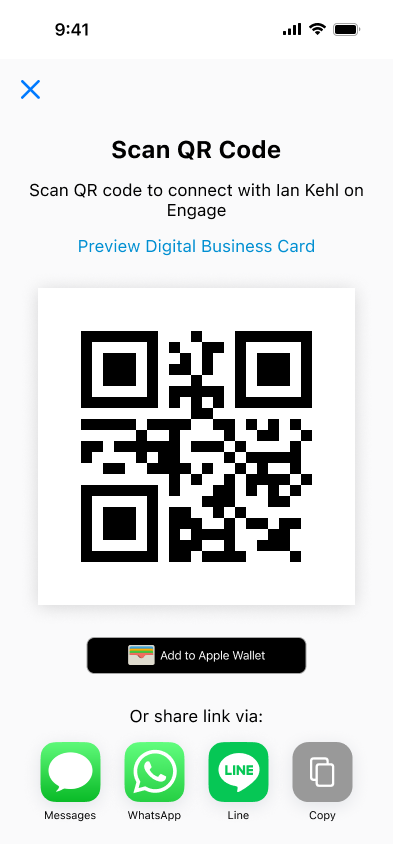
In the Apple Wallet, the QR Code® displays company information and branding according to the Engage Connect Group settings for the user. See List of Engage Connect Group Settings for more information.
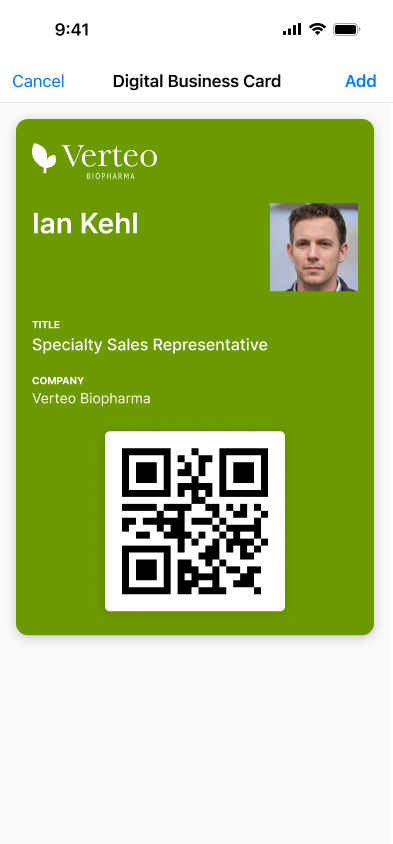
The DBC remains up-to-date in Apple Wallet and automatically expires when one of the following occurs:
- The user is deactivated
- DBC is disabled for the user
A Sent_Message_vod record is created each time a user adds their DBC to the Apple Wallet and a Message_Activity_vod record is created each time an HCP views the DBC by scanning the QR Code® in the Apple Wallet.
Tracking Engage Connection Invite Links
Information about each sent invite link is tracked on a Sent_Message_vod record. Users can view the Sent_Message_vod records for an account on the account timeline. The following information is stamped on each record:
If the full URL for an invite link is sent instead of the shortened URL, the reason is stamped in the Details_vod field on the Sent_Message_vod record.
|
Field |
Value |
|---|---|
|
Record Type |
Engage_Connection_Invite_vod |
|
Account |
Lookup to the account who received the link. This is blank when the invite is sent from the Engage tab. |
|
User |
Lookup to the user who sent the link |
|
Capture Datetime |
The datetime at which the sharing option was selected |
|
Shortened Engage Link |
The shortened version of the invite link |
|
Engage Link |
The Engage Connect server for the org and parameters for the User ID, Org ID, and Account ID |
|
Mobile ID |
System-generated Id |
|
Sent From Platform |
The platform from which the link was sent |
|
Sent Via |
The app/sharing option used to send the link |
|
Transaction Type |
Engage_Connection_Invite_vod |
Each time the recipient accesses the invite link, a Message_Activity_vod record is created with the following information:
|
Field |
Value |
|---|---|
|
Record Type |
Message_Activity_vod |
|
Activity |
Clicked_vod |
|
Activity Datetime |
The datetime at which the activity occurred |
|
IP Address |
The IP address of the server/device which accessed the URL |
|
User Agent |
The User Agent details returned from the IP address |
|
Client Name |
The name of the client software |
|
Client OS |
The name of the OS family running the client software |
|
Client Type |
The type of software used to access the URL |
|
Client Device |
The type of device used to access the URL |



